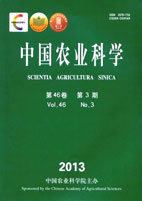-
Effects of Deficiency of N, P, or K on Growth Traits and Nutrient Uptakes of Sweetpotato at Early Growing Stage
- NING Yun-Wang, MA Hong-Bo, XU Xian-Ju, WANG Ji-Dong, ZHANG Hui, XU Jian-Ping, CHEN Jie, ZHANG Yong-Chun
-
Scientia Agricultura Sinica. 2013, 46(3):
486-495.
doi:10.3864/j.issn.0578-1752.2013.03.005
-
 Abstract
(
845 )
Abstract
(
845 )
 PDF (660KB)
(
1204
)
PDF (660KB)
(
1204
)
 Save
Save
-
References |
Related Articles |
Metrics
【Objective】The objective of the study is to accumulate the information for sweetpotato diagonosis of deficiency of nitrogen(N), phosphorus(P), or potassium(K) nutrients.【Method】A pot experiment with two sweetpotato cultivars (Sushu11 with stolons and Sushu14 with half-erect stem), four treatments (CK, -N, -P, -K) and four duplicates was conducted. A sweetpotato seedling was planted in a pot which was filled with sand, and four pots from the same treatment were placed in a plastic turnover box which was filled with solution medium. The seedlings were precultured in distilled water for three days and 1/2Hogland solution for a week, and treatment began after three new leaves had germinated. Four weeks later, the apparent deficiency symptoms appeared and the whole plant was sampled. Growth traits, photosynthetic characters, biomass accumulation and allocation, contents of N, P, and K in various plant parts of sweetpotato were investigated. 【Result】N, P, or K deficiency significantly reduced the sweetpotato shoots and total biomass (P<0.01) compared with the CK treatment, where the greatest reduction occurred at the -N treatment (P<0.01), the following was the -K treatment and the third was the -P treatment (P<0.01). N, or K deficiency significantly reduced the sweetpotato roots biomass (P<0.01 or P<0.05), however there wasn’t changes in the -P treatment (P>0.05). N or P deficiency significantly reduced the sweetpotato dry weight ratio of shoot to root (P<0.01 or P<0.05), while there wasn’t changes in the -K treatment(P>0.05). Leaf area, leaf and branch number of a single plant significantly decreased under deficiency of N, P, or K (P<0.01), the largest decrement of that occurred at the -N treatment, which were significantly lower than that of the -P and -K treatment (P<0.01). Length of main stem of the two cultivars had a significant decrement in the -N treatment (P<0.01), however, that of the -P or the -K treatment were concerned with the sweetpotato varieties, which significantly decreased for Sushu11 (P<0.01) and had no changes for Sushu14 (P>0.05). SPADs value of the 6th-8th function leaves was significantly decreased under deficiency of N or K(P<0.01), however it was significantly increased under deficiency of P(P<0.01). Deficiency of N, P, or K could significantly decrease net photosynthetic rate(P<0.01), but had no effects on transpiration rate and intercellular CO2 concentration(P>0.05). Stomatal conductance significantly decreased under deficiency of N or K(P<0.05), however there weren’t changes under deficiency of P(P>0.05). Contents of corresponding N, P, or K in various parts of sweetpotato significantly decreased under the condition of the -N, -P, or -K treatments. N deficiency could significantly decrease K contents of aboveground plant(leaf, petiole, and stem)(P<0.01) and increase P content of roots (P<0.01). P deficiency could significantly decrease N contents of leaf and petiole, K contents of petiole and stem (P<0.01), however increase K content of roots (P<0.05). Under the condition of K deficiency, N and P contents of petiole significantly decreased(P<0.01), P content of leaves and roots significantly increased (P<0.01). According to the results of this experiment, contents of N, P, and K in leaves under the condition of normal growth were 25.0-44.8 mg•kg-1(average 34.9 mg•kg-1), 2.7-6.3 mg•kg-1 (average 4.2 mg•kg-1), and 17.4-32.7 mg•kg-1 (average 25.2 mg•kg-1 ), respectively. When contents of N, P, and K in leaves were 10.0 mg•kg-1, 1.3 mg•kg-1, and 5.1 mg•kg-1 respectively, the apparent deficiency symptoms occurred. 【Conclusion】The results could provide references for the sweetpotato diagnosis under deficiency of N, P, or K in early growing stage.









